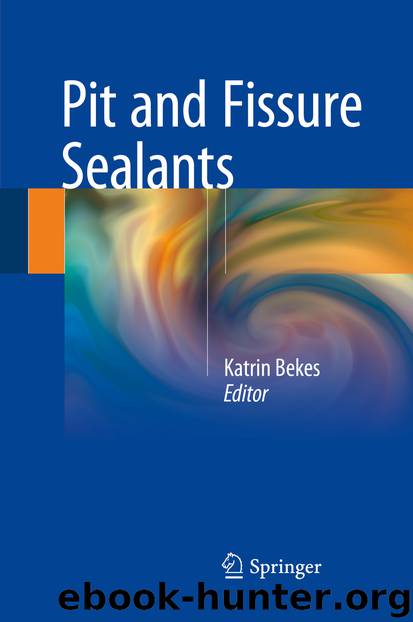Pit and Fissure Sealants by Katrin Bekes

Author:Katrin Bekes
Language: eng
Format: epub
Publisher: Springer International Publishing, Cham
Keywords
SealantPit and fissure sealantClinical recommendationsCleaningEtchingApplicationIsolationEvaluationMonitoring
7.1 Introduction
Pit and fissure sealants are one of the most highly recommended and widely accepted preventive dental procedures. Their effectiveness for caries management in the pits and fissures of mainly the occlusal tooth surfaces in children and adolescents has been documented in numerous clinical studies. A Cochrane review found that sealants placed on the occlusal surfaces of permanent molars in children and adolescents reduced caries up to 48 months when compared to the no sealant control [1]. According to a meta-analysis of 24 studies, the overall effectiveness of autopolymerized fissure sealants in preventing dental decay was 71% [2].
Pit and fissure sealants act as a physical barrier to decay. They prevent access by cariogenic bacteria to their source of fermentable nutrients [3]. The ability to protect is determined by and directly correlated to the sealant retention to the tooth surface. The protection afforded by this layer is reduced or lost when the marginal seal between the tooth and the sealant is compromised [2, 4]. Success with dental sealants is very dependent on the correct application protocol. The application, while inherently simple, is very technique-sensitive, requiring attention to detail at all stages [5]. While there is no guarantee that a sealant is going to survive on any particular surface for a specified period of time, studies show that correctly placed sealants are likely to be retained over a period of years rather than months or weeks [6].
Each sealant material requires specific techniques for their designed adhesion onto enamel. Resin-based sealants rely on a micromechanical bond made possible by the use of an acid-etch technique, which creates micropores in the enamel that interlock the resin and enamel. Glass ionomer sealants bond chemically to the enamel without the use of the acid-etch technique, which makes them less vulnerable to moisture. The choice between resin/composite and glass ionomer sealants should be based on suitability of moisture control. Because resins are most durable, they should generally be preferred. However, glass ionomer sealants should be used in patients where moisture control is difficult (e.g., in erupting or newly erupted teeth). In these cases, a fissure sealing with glass ionomer is regarded more as a provisional therapy [7].
Download
This site does not store any files on its server. We only index and link to content provided by other sites. Please contact the content providers to delete copyright contents if any and email us, we'll remove relevant links or contents immediately.
| Administration & Medicine Economics | Allied Health Professions |
| Basic Sciences | Dentistry |
| History | Medical Informatics |
| Medicine | Nursing |
| Pharmacology | Psychology |
| Research | Veterinary Medicine |
Essentials of Biostatistics in Public Health by Sullivan & Sullivan(1368)
Critical Thinking: Understanding and Evaluating Dental Research by Donald Maxwell Brunette(1320)
The Dental Diet by Steven Lin(1186)
One of the Guys by A.R. Perry(1177)
Basic Biostatistics by B. Burt Gerstman(1169)
Tooth Whitening Techniques by Linda Greenwall(1139)
0263927350 by A. L. Bird(1090)
ACT Prep 2019 by Kaplan Test Prep(1080)
Cure Tooth Decay: Heal And Prevent Cavities With Nutrition - Limit And Avoid Dental Surgery and Fluoride [Second Edition] 5 Stars by Nagel Ramiel(1069)
46 Where There Is No Dentist by Where There Is No Dentist(1054)
Dental Practice: Get in the Game by Michael Okuji(1041)
Essential Dental Therapeutics by David Wray(1026)
Small Animal Dentistry by Heidi B. Lobprise(1016)
Bone Biology, Harvesting, Grafting For Dental Implants by Arun K. Garg(996)
Dental Caries by Zhou Xuedong(988)
A Textbook of Dental Homoeopathy by Dr Colin B. Lessell(985)
Fundamentals of Operative Dentistry by James B. Summitt(982)
Dentistry with a Vision: Building a Rewarding Practice and a Balanced Life by Gerald I. Kendall Gary S. Wadhwa(981)
Uncomplicate Business: All It Takes Is People, Time, and Money by Howard Farran(931)
